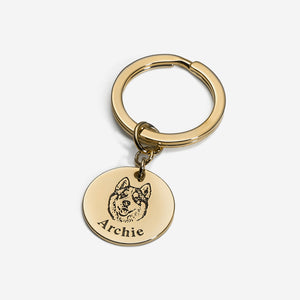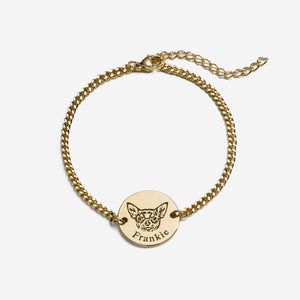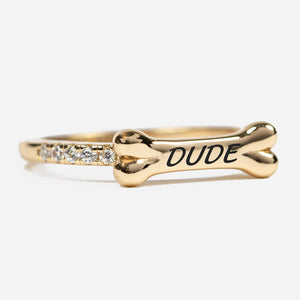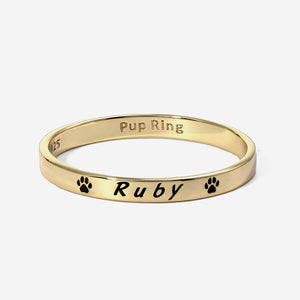Do you worry about leaving your pup at home alone? Do you come home only to find destroyed furniture or a puppy accident on the floor? Do you see your dog getting nervous when you put on your coat, and hear your pooch howling as soon as you close the front door? Your dog may be suffering from separation anxiety.
The phrase “separation anxiety” is thrown around a lot, but there is a bit of a difference between learned responses to your absence versus true dog separation anxiety. Sometimes our dog learns to act a certain way when we’re gone to get attention, or they simply have too much energy and nowhere for it to go.
First and foremost, in a case of severe separation anxiety, you should consult your vet and/or a professional dog behaviourist for help. A good way to tell that it’s not just a learned behaviour, but true separation anxiety, is to keep an eye out for signs of strong emotional distress in your dog- excessive drooling and shaking are the main ones. It’s really important to address separation anxiety because, in extreme cases, your dog might end up seriously hurting itself trying to escape- think broken teeth from gnawing on a cage, or bloody claws from trying to dig its way out of a room.
It’s important to address the underlying issue causing your dog’s anxiety. You want to set your dog up for success when you’re gone. You have to teach your dog to associate good things with your absence, as well as help it have experiences where it is alone without getting anxious.
Here is a general plan for teaching your dog how to be home alone without anxiety. Keep in mind you might need to modify some of the steps to suit your dog specifically. You should consider what you need to do before, during, and after your departure to set your dog up for success. You should also remember to take it slow- once your dog succeeds in one step, don’t move on right away, or your dog might panic and you’ll need to start over. Any time this happens, it will take much longer to get over that step than before. Finally, You can also skip steps, but it’s best to only do so if your dog doesn’t have any trouble with the step when you begin training and practicing.
This entire process is not one that should be rushed. Try to set aside more time than you think you need. The last thing you want to do is to have to stop right in the middle of practicing to go do something else.
Do this by thinking of what you always do when you leave. This might include picking up keys, putting on shoes or a coat, anything that you do exclusively before you leave. Be on the lookout for other things that your dog pays close attention to. You’ll want to practice that action without actually leaving to teach your dog not to recognize those actions as a sign you are leaving. This is also important because it will also teach your dog not to start building up anxiety when you do those things.
Put on your coat and go sit on the couch for a while. Pick up the keys and go do chores around the house. As long as you perform the “leaving” signal without leaving, you’re doing good! After several consecutive sessions where your dog stops caring about you performing these actions, you’re ready to move on to the next step.
You will need to adjust this step based on where your dog is at. Anytime you notice your dog exhibiting signs of anxiety, you now know where you need to start practicing. You should always aim to stop a little bit before your dog begins to get anxious. Anxiety is a vicious cycle- your dog gets anxious, you leave, and your dog continues to get more and more anxious as time progresses. This is why it is so important to take things as slow as possible.
This is pretty self-explanatory. Once you are able to walk outside, increase the amount of time that you wait before returning. If your dog starts to get nervous after 5 minutes, practice being outside for 4 ½ minutes, and do this repeatedly until you are confident that your dog is ready to go longer. It will probably take several weeks or even months of regular practice to be ready to be home alone as long as necessary. Do this until your dog is able to be home alone for at least 30-60 minutes with no symptoms or destructive behaviours. This is a good indicator that your dog will no longer suffer from separation anxiety during longer periods.
There are some very important things for you to keep in mind before and during training, some tips and tricks, and other questions you might have.
A tired dog is a good dog! This will especially help if your dog is acting out because it is bored. You can go on a brisk walk or run, play fetch in the yard, or go to a dog park. Sometimes putting your dog in daycare to play with other dogs once in a while is a surefire way to make sure your dog gets all the exercise and mental stimulation it needs!
Your dog will associate you being gone with an extra-special experience. This especially works well if you give a puzzle treat that will take your dog a long time to solve. Just make sure your dog knows how to use these toys before you start training them to be alone, otherwise they will associate the toy as a signal you are leaving before they can associate the toy with a good experience.

A common question is whether you should crate your dog while you are away. While crate training can be extremely beneficial to some dogs as a personal safe space, if your dog reacts very negatively to the crate, their anxiety will skyrocket. You might consider crate training your dog, just keep in mind this will take a considerable amount of time and effort. Some dogs do better if they are able to roam the house like they normally would when you are home.
Certain dogs have been bred to perform certain jobs, and that might make them more likely to develop separation anxiety in different situations. For example, because beagles were bred to assist a hunter individually, they might be more attached to their human than other breeds. Beagle separation anxiety tends to be easier to address by leaving the dog free to roam a small central section of the house. Dachshund separation anxiety is also more likely to happen than other breeds because they were also bred to help hunters catch weasels. Both beagles and dachshunds might also benefit from puzzle toys to keep their minds occupied, or might enjoy being left with something that smells like their owner.
However, in other cases like greyhound separation anxiety, it might develop because they are specifically bred for racing and tackling obstacle courses. You can see why being stuck alone in a confined space might be more troublesome for a greyhound than other breeds. Since it is bred for a cardio-heavy competitive sport, it’s extra important to make sure a greyhound gets plenty of exercise on a regular basis. Also, don’t be surprised if your greyhound can’t be confined by a baby gate!
Having some kind of noise in the background might help your dog. Think of the sounds your dog would normally hear while you are home: a TV in the background, music, or something else.
Although the presence of another dog might help separation anxiety in some cases, it all depends on the severity of the anxiety and the condition of the other dog. Best case scenario, both dogs keep each other happy while you are away. However, you might instead end up with 2 dogs with separation anxiety! Don’t plan to adopt another dog for the sole purpose of relieving your dog’s separation anxiety.
A common myth is that letting your dog sleep in bed with you will cause separation anxiety, but there’s not strong evidence to support this. If you want you can encourage your dog to sleep elsewhere, and it might help, but if you try to force your dog out of bed and stress it out, it might actually make the situation worse.
Taking the time to train your dog will help boost its confidence! When your dog learns to do new things, this helps your dog learn to not always rely on you for everything. Obedience training is helpful, and it also exercises your dog’s mind.
Above all, it’s important for your dog to be safe. If you're concerned your dog's behavior is dangerous to its health, you should seek out a specialist. Professional help will help you get a better understanding of how to help your dog. In some cases it might be appropriate for your dog to take a prescription medication for its anxiety or some other form of treatment, such as soothing sprays. A dog behaviourist can also really help you address severe cases of separation anxiety.
 Whether you just need it while you are training your dog, or in cases where you are unable to resolve your dog’s separation anxiety, consider alternatives to leaving your dog home alone. You can put your dog in daycare, hire a dog walker, or let a friend or relative care for your dog during the day. In the end, we cannot stop going to work or running errands to be home with our dog for the rest of its life.
Whether you just need it while you are training your dog, or in cases where you are unable to resolve your dog’s separation anxiety, consider alternatives to leaving your dog home alone. You can put your dog in daycare, hire a dog walker, or let a friend or relative care for your dog during the day. In the end, we cannot stop going to work or running errands to be home with our dog for the rest of its life.Your dog’s separation anxiety might be affecting more than their feelings and behaviour- it might be affecting you too, and not just because they’re destroying your stuff. Dogs are extremely receptive to their owner’s behaviour and emotions. No matter how good you think your poker face is, your pup knows, and feeds off your energy, so if you are nervous or upset, your dog will be too. It’s important to address your own feelings or it will be much more difficult to help your dog. If you struggle with your emotions while trying to train your dog- anxiety, anger, something else- it might be especially important to get professional help from a vet or dog behaviour specialist. They will not only help teach your dog to manage its anxiety, but will also help you form a better approach to training your dog and your relationship with your dog.
It might also be important for you to find ways to manage these emotions on a personal level. I personally really struggle with my own dog’s separation anxiety. I have severe anxiety myself, and it’s a vicious cycle of me panicking when I have to leave, and my dog seeing how upset I am and getting anxious in turn. We respond to each other, and while it is important to focus on training my dog to deal with his separation anxiety, I also need to focus on showing him I am calm and confident when I have to leave. My PupRing is a really helpful reminder of this- it helps me remember to be strong for my dog and be a good role model to him with my emotions. When I’m about to leave I make sure I’m wearing it as that reminder- that’s my own signal to calm down!
Hopefully this has given you all the tools and knowledge you need to start helping your dog with its separation anxiety. It’s difficult, and quite a long process, but it is so rewarding in the end, and so good for your pup. I wish you the best of luck!






